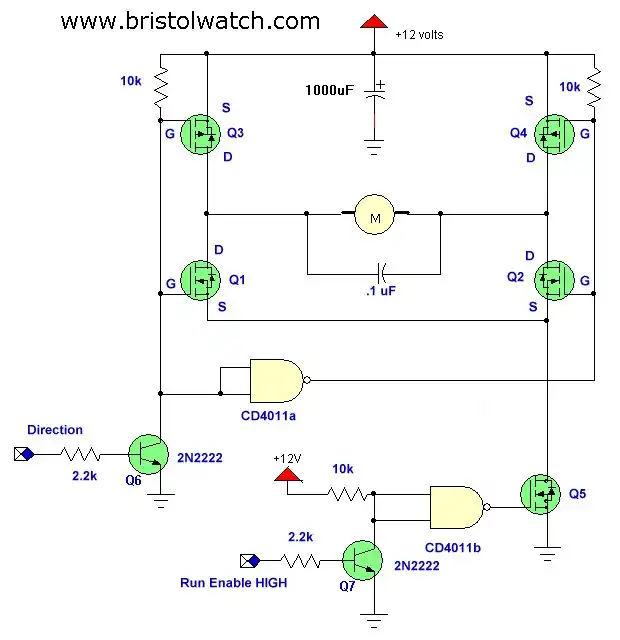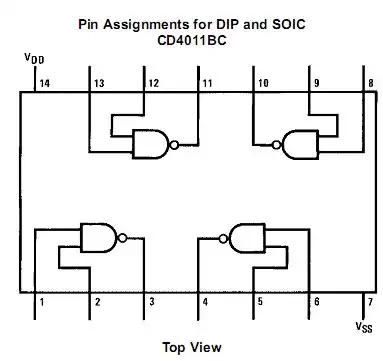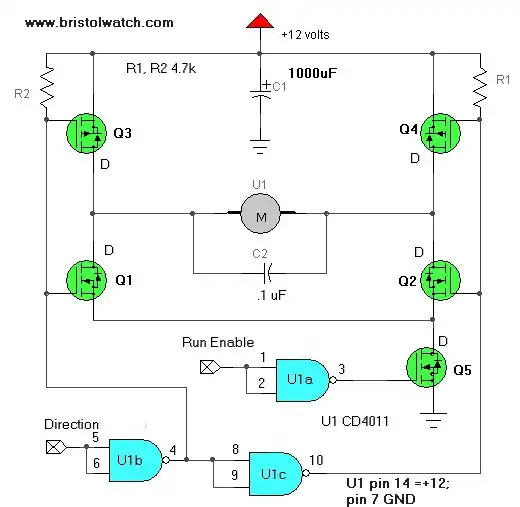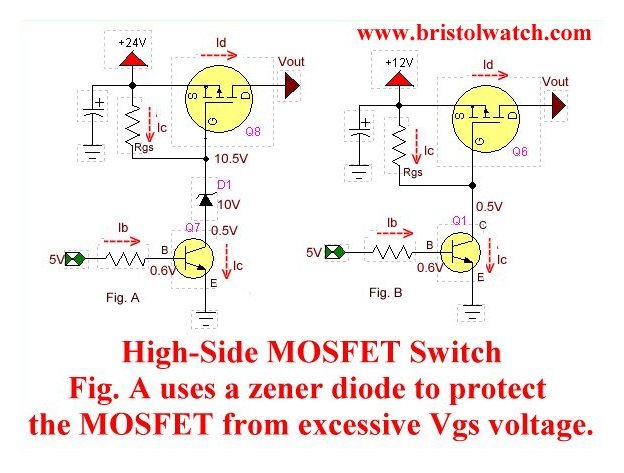
Figure 1
More Power MOSFET H-Bridge Circuit Examples
by Lewis Loflin
Here we look at some variations for my power MOSFET H-bridge.
In the variation above we have an enable pin to turn the H-bridge on/off and a separate direction pin. A 'HIGH' turns on Q7 driving its collector 'LOW' and through CD4011b being used as an inverter produces a 'HIGH' on the gate of Q5 turning the MOSFET on, thus the motor will run. Note the power connections for the CD4011 not shown.
With a 'LOW' or zero volts on the Direction pin the collector of Q6 is 'HIGH' Q1 and via CD4011a Q4 are turned on (Q2 and Q3 are turned off) creating a current path through Q1, the motor, and Q4. When the Direction pin goes 'HIGH' (5-volts) Q6 switches on driving its collector to 'LOW' switching off Q1 and Q4 and turning on Q2 and Q3 creating a reverse current path through Q2, the motor, and Q3.
There are few calculations to be done with this circuit. The ratings of Q1-Q5 depends on the motor and the operating voltage is limited to 15 volts due to the CD4011. This was designed to connect to a 5-volt microprocessor.
Parts list:
Q1, Q2, Q5, N-channel MOSFET IRF630
Q3, Q4, P-channel MOSFET IRF9630
Note that if using the above listed MOSFETs Vcc is limited to20-volts due to Vgs. For more on that see the following:
- N-Channel Power MOSFET Switching Tutorial
- P-Channel Power MOSFET Switch Tutorial
- H-Bridge Motor Control with Power MOSFETs

Figure 2. Cd4011 pin connections.

Figure 3.
Another variation of the above circuit. Note that the run enable in both circuits can be pulse-width modulated to control motor speed.

Figure 4
This circuit can be used to cut Vcc on/off and also be pulse-width modulated to control motor speed.
- Quick navigation of this website:
- Basic Electronics Learning and Projects
- Basic Solid State Component Projects
- Arduino Microcontroller Projects
- Raspberry Pi Electronics, Programming
- ULN2003A Darlington Transistor Array with Circuit Examples
- Tutorial Using TIP120 and TIP125 Power Darlington Transistors
- Driving 2N3055-MJ2955 Darlington Transistors
- Understanding Bipolar Transistor Switches
- N-Channel Power MOSFET Switching Tutorial
- P-Channel Power MOSFET Switch Tutorial
- H-Bridge Motor Control with Power MOSFETs
- Arduino Controlled IR2110 Based H-Bridge HV Motor Control
- IGBT Based High Voltage H-Bridge DC Motor Control
- More Power MOSFET H-Bridge Circuit Examples
- Build a High Power Transistor H-Bridge Motor Control
- Related:
- N-Channel Power MOSFET Switching Tutorial
- P-Channel Power MOSFET Switch Tutorial
- Test Power MOSFET Transistors, Observations
- Issues on Connecting MOSFETs in Parallel
- Basic MOSFET Transistor Test Circuits
- High Voltage MOSFET Switching Circuits
- Why Your MOSFET Transistors Get Hot YouTube
- Issues on Connecting MOSFETs in Parallel YouTube
- Simple Circuits for Testing MOSFET Transistors YouTube
See the following spec sheets:
- Basic Triacs and SCRs
- Constant Current Circuits with the LM334
- LM334 CCS Circuits with Thermistors, Photocells
- LM317 Constant Current Source Circuits
- TA8050P H-Bridge Motor Control
- All NPN Transistor H-Bridge Motor Control
- Basic Triacs and SCRs
- Comparator Theory Circuits Tutorial
Web site Copyright Lewis Loflin, All rights reserved.
If using this material on another site, please provide a link back to my site.